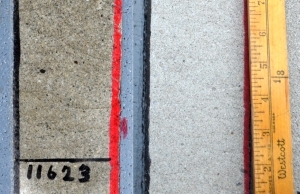Dish Structures
 When the sand suspended in a turbidity current suspension starts to settle out, incipient clay laminations may begin to form concurrent with the upward movement of water that has been forced out from between the settling sand grains. Dewatering pipes within the sand may then form, and distort these clay laminations to form concave-up patterns that resemble small dishes. Although dish structures typically are small features with individual dishes being an inch or two across, some huge dish structures several inches across are shown on the right in a photo of an outcrop from Talara, Peru by Zoltan Sylvester. When the sand suspended in a turbidity current suspension starts to settle out, incipient clay laminations may begin to form concurrent with the upward movement of water that has been forced out from between the settling sand grains. Dewatering pipes within the sand may then form, and distort these clay laminations to form concave-up patterns that resemble small dishes. Although dish structures typically are small features with individual dishes being an inch or two across, some huge dish structures several inches across are shown on the right in a photo of an outcrop from Talara, Peru by Zoltan Sylvester.
|
Examples of Dish Structures from the San Joaquin Valley of California

Dish Structures in outcrop
Middle Eocene Point of Rocks SS
Salt Creek, Temblor Range
West Margin San Joaquin Valley, CA |

Dish Structures in outcrop
(cross-section view)
Lower Miocene Carneros SS (Temblor Fm)
Cedar Creek (Bitter Water Canyon area)
Temblor Range
West Margin San Joaquin Valley, CA |

Dish Structures in outcrop
(top view looking down)
Lower Miocene Carneros SS (Temblor Fm)
Carneros Creek Type Section
Temblor Range
West Margin San Joaquin Valley, CA |

Dish Structures in core
Middle Miocene Nozu Sandstone
Monterey Formation
36X-14 well, Stockdale Ranch oil field
San Joaquin Valley, California |